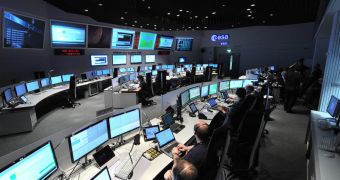Officials at the European Space Agency (ESA) are happy to report that the Rosetta spacecraft, recently brought back online after a 31-month hibernation period, was successful in turning on all the instruments mission controllers activated to date.
The probe woke up after receiving the first signal from the ESA European Space Operations Center (ESOC), in Darmstadt, Germany, on January 20, 2014. Just a few short hours afterwards, at 1818 GMT, the first signal from the mission reached mission controllers.
Hibernating in space is a difficult task for any spacecraft. Rosetta has spent more than two years in this state, which was induced by ESA experts to preserve power in the spacecraft. The probe will spend a total of more than 10 years traveling through the solar system, having launched on March 2, 2004.
Its main mission is to rendezvous with comet 67P/Churyumov–Gerasimenko. Once it enters orbit around this celestial body, Rosetta will release its Philae lander, which will use grappling hooks to affix itself to the object. The tiny robot will then use its 10 instruments to conduct the most comprehensive set of studies of a comet's surface ever conducted.
When the probe was first reawakened, it began warming itself up, and then its computers booted in a safe mode designed to protect its sensitive instruments from the effects of possible power failures. Over the next few hours, ESOC controllers gradually activated numerous components, which all responded flawlessly to commands.
Three of the four reaction wheels on the spacecraft are now online. These devices enable the vehicle to maintain its orientation in space, and enable precision pointing for the instruments on board. The fourth reaction wheel – which is a backup – will be checked over the coming weeks.
“We were most concerned about power, and seeing if the solar arrays were generating sufficient electricity to support the planned recommissioning activities,” explains the manager of Rosetta operations at ESOC, Andrea Accomazzo.
“But even though we were still 673 million [kilometers, or 418 million miles] from the Sun, we were getting enough power and the arrays appear to have come through hibernation with no degradation,” the expert goes on to say.
“Over the next three months we will be making sure that each instrument is ready to perform once we finally arrive at the comet, after 10 years journeying through the Solar System,” concludes the manager of the Rosetta mission at ESA, Fred Jansen.

 14 DAY TRIAL //
14 DAY TRIAL //